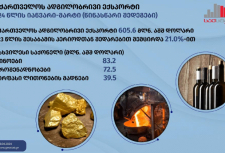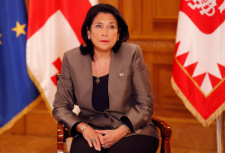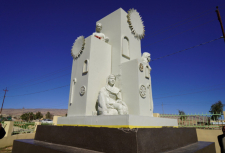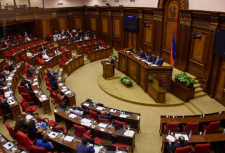The story of Ezidi Mirza: From orphan to hero
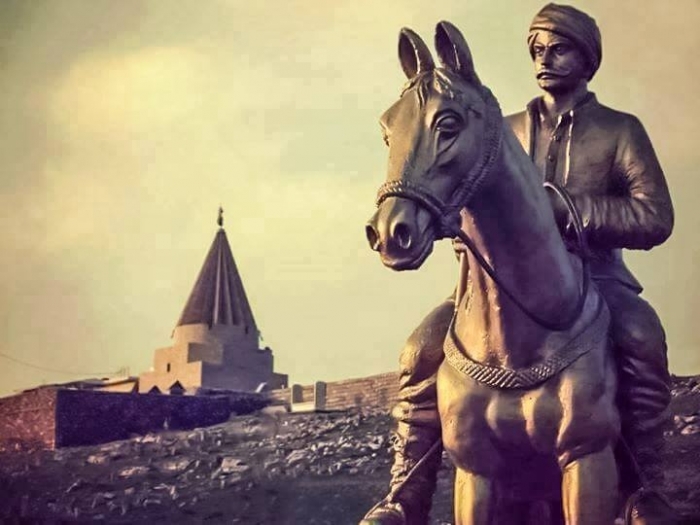
"How long has the spirit of Ezidi Mirza been lost in the Yazidis, and how long will they shed tears on their knees?" says a poem by a Yazidi poet dedicated to the genocide in Shangal. In this period of destruction, hatred and powerlessness, the Yazidis need more than ever a liberator, a strong leader who will be able to lead their people and solve all the issues facing the community, as well as continue the traditions of the legendary hero Ezidi Mirza. Because of the persecution and hostile environment, the Yazidis were closed to the distribution of letters. Instead of writing their own history and revealing the basics of their worldview, the Yazidis were constantly fighting for survival. To preserve their history, they had to create a complex oral tradition that remained in the collective memory of society and was passed down from generation to generation.
In Yazidi poems, epics and fairy tales, the memory of numerous heroes who gave their lives in the name of saving their people is still alive. But among them all, the name of Ezidi Mirza (1600 – 1651) stands out, who is still the epitome of heroism. Unfortunately, its history is not known to many people, although the ruins of its castle can still be found near the banks of the Tigris.
So who is this person about whom the famous Ottoman traveler Evliya Celebi (1611 – 1683) writes, and who is mentioned in the" Ottoman History " of Naim (1655-1716)? As often happens in Yazidi history, the fate of Ezidi Mirza is full of losses and persecution. But he managed to survive all this and be reborn, which still gives hope to the entire Yazidi community.
Childhood
Ezidi Mirza was born in 1600 in the village of Bashiqa. He was the youngest of three brothers. His family came from the spiritual caste of sheikhs, who were very popular among the Yazidis. Mirza's father, Sheikh Sheho, was a highly respected scholar.
Bashiqa and the neighboring village of Bahzan have always been the most important and unique Yezidi settlements. The native language of the local Yazidis is the Arabic dialect of historical Syria, which they have preserved to this day. It is also home to the center of the "guardians of Yazidism", the kavals, who pass on the oral tradition of the Yazidis to the next generations.
A few years after the birth of Mirza, in 1605, a fateful day came, which had a tremendous impact on his future fate. Numerous Kurdish tribes from Soran and Goran attacked the Yezidi principality of Sheikhan, Bashiqa and Bahzan. Sheikh Sheho mobilized Yazidi fighters and organized resistance, but the forces of the parties were unequal. The attackers carried out mass killings of the Yazidi population, looted their villages and abducted women and children. The supreme leader of the Yazidis arrived with his army from Sheikhan to help the residents. As a result of fierce fighting, the enemy retreated. Mirza and his two brothers survived, but they were forced to witness the murder of their father, mother, and most of the family members. In the coming years, Mirza, his brothers Amar and Haidar had to go through many difficulties.
Captivity
The brothers often spent time in the markets, a few kilometers from the city of Mosul, which was under the rule of the Ottoman Empire. Like all orphans, they lived in poverty and often stole food without being noticed. One evening, the brothers stole melons and onions from a local farmer. The next day, he was waiting for them, hiding in a field, and when the boys came again to steal food, the farmer grabbed them and handed them over to the Ottoman soldiers. After it became known that the brothers were Yazidis, they were severely beaten. One of the Ottoman soldiers resorted to extreme cruelty: he promised his older brother Haidar that he would be released if he killed his brothers. But Haidar and his middle brother Amar flatly rejected the offer. Then the soldiers put a knife in the hands of Mirza's younger brother and forced him to cut the throats of his brothers. With his clothes covered in blood, Mirza was later dumped on a street in Mosul.
Mirza, who was crying and wandering through the streets of Mosul, was recognized by a well-known merchant, who returned him to Bashiqa. Thus, Mirza lost the last of his relatives, and he had a hand in this. Descended from a prominent family of Qatani sheikhs, he was raised by the Yazidi clergy. Mirza was trained in the Yazidi religion and, unlike many, could read and write Arabic. As an adult, he married and became a teacher himself. The Yazidis addressed him respectfully as "Sheikh Mirza". However, he was interested not only in religion, but also in military strategy and tactics. The constant Muslim attacks on the Yazidis and his own life story convinced him of the need to create a powerful army.
The first victory
15 years after the major attack on Bashiqa and Bahzan, in which Mirza lost his parents, the Yazidis were again attacked by Kurdish and Arab tribes. Despite the numerical superiority of the attackers, the Yazidis, led by Mirza, took up arms and defended their villages. Mirza could now prove how well he had mastered military tactics. Gathering the best fighters under his command, he prepared a counteroffensive. Using the terrain, Mirza's troops cornered the enemy and inflicted a crushing defeat on them. The news of Mirza's victory spread like wildfire through the region and was greeted with enthusiasm by the Yezidis of Shangal. Thus, 20-year-old Mirza became a hero. Ottoman sources say he had about 3,000 trained Yazidi fighters under his command. In the region, he became known as Ezidi Mirza. At the age of 25, he was appointed head of the Yazidis in Bashiqa and Bahzan and worked closely with the Yazidi leader Mir Zainal beg Chawhal.
The war between the Ottomans and the Safavids, which began in 1623, lasted until 1639, and the Yazidis were caught between a rock and a hard place. Ezidi Mirza, who was recognized as the Yazidi military leader, realized that his people could only survive in this war if they chose one of the sides. However, making the decision wasn't difficult. Since their invasion, the Safavids have killed thousands of Yazidis and spared no prisoners. The Ottomans were placed in close proximity to the Yazidis and as a result of the uprising, the Yazidi villages would be attacked directly.
In the reports, the Ottoman chronicler Naim reports that Ezidi Mirza was recognized as the commander of the Yezidi fighters personally by Sultan Murad IV. The Ottoman reports note the heroic actions of Ezidi Mirza during the Battle of Baghdad between the Safavids and the Ottomans. He was also joined by six other important Yazidi leaders.
Siege of Baghdad
The troops of Sultan Murad IV long besieged Baghdad, which was under the control of the Safavids. In 1639, a large-scale offensive began. During the fighting, the Yazidi troops were not only able to hold the line, but also went on the offensive against the Safavid positions, killing a prominent commander. After this, the enemy was demoralized and Ezidi Mirza decided to advance further, attacking the positions of the troops of Saru Khan, the Safavid commander. The Yazidis won an important victory without heavy losses. The success of Ezidi Mirza did not go unnoticed by the Ottomans. The new government accepted the Yazidi leader and stood up to protect the Yazidis from attacks by Arab and Kurdish tribes. A period of peace and security has arrived in Sheikhan.
However, it did not last long. As early as 1640, Ottoman troops attacked the Yezidis of Shangal. Earlier, the local Yazidis managed to defeat the troops of the commander of the Ottoman army, Nasuh Pasha, as a result of which, according to Evliya Celebi, about 7,000 Ottoman soldiers were killed. The Yazidis controlled all trade routes to Shangal and the surrounding area, which caused concern among Muslims. They refused to pay taxes and even attacked Ottoman caravans. All this prompted the governor of Diarbakir, Malak Ahmad Pasha, who was known for his hatred of the Yazidis, to lay siege to Shangal with 70,000 soldiers. He called on the Yazidis to pay their taxes. But they decided to retreat to the mountains and organize resistance, which led to another war. Despite being outnumbered, the Ottoman forces suffered heavy losses before they could gain the upper hand over the Yazidis.
These circumstances did not prevent Ezidi Mirza from consolidating his power in the next decade by increasing the number of his troops and contacting high-ranking Ottoman officials. Having a lot of political weight, he could easily shift leader of all Yezidis Mir Zeynal-run Chavala but didn't. On the contrary, he did not interfere in his affairs and consulted him in everything. After his success during the siege of Baghdad and the increase in the number of troops, attacks on Yazidi villages by hostile tribes decreased.
Appointment by the Governor
Ezidi Mirza reached the peak of his power in 1650. During this time, he met Kara Murad Pasha, the grand vizier of the Ottoman Sultan and the second most influential person in the Ottoman Empire. Using his power, Mirza demanded to be appointed governor of Mosul. His request was granted. It was the highest position ever held by a Yazidi in the Ottoman Empire. And on the way to this position, he has put English interests ahead of their own.
After his appointment, Mirza Aside began to take revenge for his brothers. First of all, he ordered the destruction of the property of the farmer, who at one time handed them over to the Ottoman soldiers. Then he was harsh: he ordered the arrest of all the descendants of the Ottoman soldiers and guards who had mistreated him and his brothers in prison. Mirza made the decision that they should all go through the same torment that he went through as a child.
In Mosul, near the banks of the Tigris River, Ezidi Mirza restored a Yazidi shrine and built a temple in honor of Saint Pir Qadiblban. Since then, he has lived in his castle in Mosul, the ruins of which remain to this day. During their short reign, the Yazidis enjoyed unprecedented protection. They could work and trade without fear or reprisals. Thus, the prosperity of the Yazidis began. But it didn't last long. A year later, Kara Murad Pasha was deposed from his post and the position of the governors appointed by him was dramatically weakened. The new Grand Vizier of the Ottoman Empire was Malak Ahmed Pasha, who was responsible for the Yazidi attack on Shangal. His hatred of the Yazidis was enormous, and he decided to remove Ezidi Mirza.
When Mirza was informed of these plans, he started an uprising. In 1651. Ezidi Mirza, along with 60 fighters, was returning to his native village, where the Ottomans ambushed him. They surrounded the Yazidi leader and attacked him. Ezidi Mirza was killed at the age of 51. Evliya Celebi reports that the Ottoman soldiers beheaded Mirza's corpse and displayed his head at the gate of the Topkapi Palace.
After the Yazidis learned of the murder of Ezidi Mirza, they planned an uprising. This prompted the Ottoman authorities, including Malak Ahmed Pasha, to attack the Yazidis again. But Ezidi Mirza's fighters were well-trained. Now they are led by the Yazidi commander Imadin Hakkari, who was supported by Mir Zainal-beg Chawhal, sending thousands of his fighters as reinforcements. The strength of the Yazidi army was thus 6,000 well-trained and armed fighters. Outnumbered and supported by Kurdish leaders and tribes, the Ottomans attacked the Yezidis of Sheikhan. Imadin Hakkari decided to take revenge for the murder of Ezidi Mirza and defeated the Ottoman-Kurdish alliance, going on the offensive and conquering a large territory, in particular the Kurdish region of Barwari. The Ottoman forces suffered such heavy losses that they themselves demanded peace talks.
In the following centuries, the Yazidis were repeatedly subjected to numerous attacks. The former power of the Yazidis of the time of Ezidi Mirza was never restored. But his achievements are still alive in the legends and songs of the Yazidis. For them, he is a hero who managed to protect the people in a difficult moment. In 2006, a monument was erected to him in Bashiqa, which was destroyed after the conquest of the village by IS terrorists.
As a result of the Shangal genocide, the Yazidis created their own armed forces to defend themselves. And the troops of Ezidi Mirza act as a model for them. For example, the soldiers of the Shangal Self-Defense Forces (SSF) have repeatedly stated that they are "grandsons of Ezidi Mirza".
Links:
1. Allison, Christine (2001): The Yezidi Oral Tradition in Iraqi Kurdistan, Curzon Press.
Dankoff, Robert (1991): The Intimate Life of an Ottoman Statesman, Albany: State University of New York Press.
2. Guest, John S. (1993): Survival Among the Kurds: A History of the Yezidis, reprinted: Guest, John S. (1987): The Yezidis: A Study in Survival, New York und London.
3. Hecî, Bedel Feqîr (2014): Hevrikya Şemsanî, Adanî u Qatanyê li ser mîryatîya Êzidîyan, in: Êzdînas 1, Oldenburg: Dengê Êzîdiyan, S. 118 – 136.
4. Lescot, Roger (1938): Enquête sur les Yezidis de Syrie et du Djebel Sindjar, Beirut.
5. Schengali, Kheri (2011): Ezdi Mirza – ein großer Taktiker und Stratege, in: Yezidische Helden, Oldenburg: Dengê Êzîdiyan, S. 90 – 100.
6. Şingalî, Xêrî (2009): Êzîdî Mîrzayê Kendalî – Vêkolîneka dîrokî [arabic alphabet], www.bahzani.net
ÊzîdîPress
Tags: #yazidisinfo #newsyezidi #historyyazidi #aboutyazidi #ezidi
The story of Ezidi Mirza: From orphan to hero

"How long has the spirit of Ezidi Mirza been lost in the Yazidis, and how long will they shed tears on their knees?" says a poem by a Yazidi poet dedicated to the genocide in Shangal. In this period of destruction, hatred and powerlessness, the Yazidis need more than ever a liberator, a strong leader who will be able to lead their people and solve all the issues facing the community, as well as continue the traditions of the legendary hero Ezidi Mirza. Because of the persecution and hostile environment, the Yazidis were closed to the distribution of letters. Instead of writing their own history and revealing the basics of their worldview, the Yazidis were constantly fighting for survival. To preserve their history, they had to create a complex oral tradition that remained in the collective memory of society and was passed down from generation to generation.
In Yazidi poems, epics and fairy tales, the memory of numerous heroes who gave their lives in the name of saving their people is still alive. But among them all, the name of Ezidi Mirza (1600 – 1651) stands out, who is still the epitome of heroism. Unfortunately, its history is not known to many people, although the ruins of its castle can still be found near the banks of the Tigris.
So who is this person about whom the famous Ottoman traveler Evliya Celebi (1611 – 1683) writes, and who is mentioned in the" Ottoman History " of Naim (1655-1716)? As often happens in Yazidi history, the fate of Ezidi Mirza is full of losses and persecution. But he managed to survive all this and be reborn, which still gives hope to the entire Yazidi community.
Childhood
Ezidi Mirza was born in 1600 in the village of Bashiqa. He was the youngest of three brothers. His family came from the spiritual caste of sheikhs, who were very popular among the Yazidis. Mirza's father, Sheikh Sheho, was a highly respected scholar.
Bashiqa and the neighboring village of Bahzan have always been the most important and unique Yezidi settlements. The native language of the local Yazidis is the Arabic dialect of historical Syria, which they have preserved to this day. It is also home to the center of the "guardians of Yazidism", the kavals, who pass on the oral tradition of the Yazidis to the next generations.
A few years after the birth of Mirza, in 1605, a fateful day came, which had a tremendous impact on his future fate. Numerous Kurdish tribes from Soran and Goran attacked the Yezidi principality of Sheikhan, Bashiqa and Bahzan. Sheikh Sheho mobilized Yazidi fighters and organized resistance, but the forces of the parties were unequal. The attackers carried out mass killings of the Yazidi population, looted their villages and abducted women and children. The supreme leader of the Yazidis arrived with his army from Sheikhan to help the residents. As a result of fierce fighting, the enemy retreated. Mirza and his two brothers survived, but they were forced to witness the murder of their father, mother, and most of the family members. In the coming years, Mirza, his brothers Amar and Haidar had to go through many difficulties.
Captivity
The brothers often spent time in the markets, a few kilometers from the city of Mosul, which was under the rule of the Ottoman Empire. Like all orphans, they lived in poverty and often stole food without being noticed. One evening, the brothers stole melons and onions from a local farmer. The next day, he was waiting for them, hiding in a field, and when the boys came again to steal food, the farmer grabbed them and handed them over to the Ottoman soldiers. After it became known that the brothers were Yazidis, they were severely beaten. One of the Ottoman soldiers resorted to extreme cruelty: he promised his older brother Haidar that he would be released if he killed his brothers. But Haidar and his middle brother Amar flatly rejected the offer. Then the soldiers put a knife in the hands of Mirza's younger brother and forced him to cut the throats of his brothers. With his clothes covered in blood, Mirza was later dumped on a street in Mosul.
Mirza, who was crying and wandering through the streets of Mosul, was recognized by a well-known merchant, who returned him to Bashiqa. Thus, Mirza lost the last of his relatives, and he had a hand in this. Descended from a prominent family of Qatani sheikhs, he was raised by the Yazidi clergy. Mirza was trained in the Yazidi religion and, unlike many, could read and write Arabic. As an adult, he married and became a teacher himself. The Yazidis addressed him respectfully as "Sheikh Mirza". However, he was interested not only in religion, but also in military strategy and tactics. The constant Muslim attacks on the Yazidis and his own life story convinced him of the need to create a powerful army.
The first victory
15 years after the major attack on Bashiqa and Bahzan, in which Mirza lost his parents, the Yazidis were again attacked by Kurdish and Arab tribes. Despite the numerical superiority of the attackers, the Yazidis, led by Mirza, took up arms and defended their villages. Mirza could now prove how well he had mastered military tactics. Gathering the best fighters under his command, he prepared a counteroffensive. Using the terrain, Mirza's troops cornered the enemy and inflicted a crushing defeat on them. The news of Mirza's victory spread like wildfire through the region and was greeted with enthusiasm by the Yezidis of Shangal. Thus, 20-year-old Mirza became a hero. Ottoman sources say he had about 3,000 trained Yazidi fighters under his command. In the region, he became known as Ezidi Mirza. At the age of 25, he was appointed head of the Yazidis in Bashiqa and Bahzan and worked closely with the Yazidi leader Mir Zainal beg Chawhal.
The war between the Ottomans and the Safavids, which began in 1623, lasted until 1639, and the Yazidis were caught between a rock and a hard place. Ezidi Mirza, who was recognized as the Yazidi military leader, realized that his people could only survive in this war if they chose one of the sides. However, making the decision wasn't difficult. Since their invasion, the Safavids have killed thousands of Yazidis and spared no prisoners. The Ottomans were placed in close proximity to the Yazidis and as a result of the uprising, the Yazidi villages would be attacked directly.
In the reports, the Ottoman chronicler Naim reports that Ezidi Mirza was recognized as the commander of the Yezidi fighters personally by Sultan Murad IV. The Ottoman reports note the heroic actions of Ezidi Mirza during the Battle of Baghdad between the Safavids and the Ottomans. He was also joined by six other important Yazidi leaders.
Siege of Baghdad
The troops of Sultan Murad IV long besieged Baghdad, which was under the control of the Safavids. In 1639, a large-scale offensive began. During the fighting, the Yazidi troops were not only able to hold the line, but also went on the offensive against the Safavid positions, killing a prominent commander. After this, the enemy was demoralized and Ezidi Mirza decided to advance further, attacking the positions of the troops of Saru Khan, the Safavid commander. The Yazidis won an important victory without heavy losses. The success of Ezidi Mirza did not go unnoticed by the Ottomans. The new government accepted the Yazidi leader and stood up to protect the Yazidis from attacks by Arab and Kurdish tribes. A period of peace and security has arrived in Sheikhan.
However, it did not last long. As early as 1640, Ottoman troops attacked the Yezidis of Shangal. Earlier, the local Yazidis managed to defeat the troops of the commander of the Ottoman army, Nasuh Pasha, as a result of which, according to Evliya Celebi, about 7,000 Ottoman soldiers were killed. The Yazidis controlled all trade routes to Shangal and the surrounding area, which caused concern among Muslims. They refused to pay taxes and even attacked Ottoman caravans. All this prompted the governor of Diarbakir, Malak Ahmad Pasha, who was known for his hatred of the Yazidis, to lay siege to Shangal with 70,000 soldiers. He called on the Yazidis to pay their taxes. But they decided to retreat to the mountains and organize resistance, which led to another war. Despite being outnumbered, the Ottoman forces suffered heavy losses before they could gain the upper hand over the Yazidis.
These circumstances did not prevent Ezidi Mirza from consolidating his power in the next decade by increasing the number of his troops and contacting high-ranking Ottoman officials. Having a lot of political weight, he could easily shift leader of all Yezidis Mir Zeynal-run Chavala but didn't. On the contrary, he did not interfere in his affairs and consulted him in everything. After his success during the siege of Baghdad and the increase in the number of troops, attacks on Yazidi villages by hostile tribes decreased.
Appointment by the Governor
Ezidi Mirza reached the peak of his power in 1650. During this time, he met Kara Murad Pasha, the grand vizier of the Ottoman Sultan and the second most influential person in the Ottoman Empire. Using his power, Mirza demanded to be appointed governor of Mosul. His request was granted. It was the highest position ever held by a Yazidi in the Ottoman Empire. And on the way to this position, he has put English interests ahead of their own.
After his appointment, Mirza Aside began to take revenge for his brothers. First of all, he ordered the destruction of the property of the farmer, who at one time handed them over to the Ottoman soldiers. Then he was harsh: he ordered the arrest of all the descendants of the Ottoman soldiers and guards who had mistreated him and his brothers in prison. Mirza made the decision that they should all go through the same torment that he went through as a child.
In Mosul, near the banks of the Tigris River, Ezidi Mirza restored a Yazidi shrine and built a temple in honor of Saint Pir Qadiblban. Since then, he has lived in his castle in Mosul, the ruins of which remain to this day. During their short reign, the Yazidis enjoyed unprecedented protection. They could work and trade without fear or reprisals. Thus, the prosperity of the Yazidis began. But it didn't last long. A year later, Kara Murad Pasha was deposed from his post and the position of the governors appointed by him was dramatically weakened. The new Grand Vizier of the Ottoman Empire was Malak Ahmed Pasha, who was responsible for the Yazidi attack on Shangal. His hatred of the Yazidis was enormous, and he decided to remove Ezidi Mirza.
When Mirza was informed of these plans, he started an uprising. In 1651. Ezidi Mirza, along with 60 fighters, was returning to his native village, where the Ottomans ambushed him. They surrounded the Yazidi leader and attacked him. Ezidi Mirza was killed at the age of 51. Evliya Celebi reports that the Ottoman soldiers beheaded Mirza's corpse and displayed his head at the gate of the Topkapi Palace.
After the Yazidis learned of the murder of Ezidi Mirza, they planned an uprising. This prompted the Ottoman authorities, including Malak Ahmed Pasha, to attack the Yazidis again. But Ezidi Mirza's fighters were well-trained. Now they are led by the Yazidi commander Imadin Hakkari, who was supported by Mir Zainal-beg Chawhal, sending thousands of his fighters as reinforcements. The strength of the Yazidi army was thus 6,000 well-trained and armed fighters. Outnumbered and supported by Kurdish leaders and tribes, the Ottomans attacked the Yezidis of Sheikhan. Imadin Hakkari decided to take revenge for the murder of Ezidi Mirza and defeated the Ottoman-Kurdish alliance, going on the offensive and conquering a large territory, in particular the Kurdish region of Barwari. The Ottoman forces suffered such heavy losses that they themselves demanded peace talks.
In the following centuries, the Yazidis were repeatedly subjected to numerous attacks. The former power of the Yazidis of the time of Ezidi Mirza was never restored. But his achievements are still alive in the legends and songs of the Yazidis. For them, he is a hero who managed to protect the people in a difficult moment. In 2006, a monument was erected to him in Bashiqa, which was destroyed after the conquest of the village by IS terrorists.
As a result of the Shangal genocide, the Yazidis created their own armed forces to defend themselves. And the troops of Ezidi Mirza act as a model for them. For example, the soldiers of the Shangal Self-Defense Forces (SSF) have repeatedly stated that they are "grandsons of Ezidi Mirza".
Links:
1. Allison, Christine (2001): The Yezidi Oral Tradition in Iraqi Kurdistan, Curzon Press.
Dankoff, Robert (1991): The Intimate Life of an Ottoman Statesman, Albany: State University of New York Press.
2. Guest, John S. (1993): Survival Among the Kurds: A History of the Yezidis, reprinted: Guest, John S. (1987): The Yezidis: A Study in Survival, New York und London.
3. Hecî, Bedel Feqîr (2014): Hevrikya Şemsanî, Adanî u Qatanyê li ser mîryatîya Êzidîyan, in: Êzdînas 1, Oldenburg: Dengê Êzîdiyan, S. 118 – 136.
4. Lescot, Roger (1938): Enquête sur les Yezidis de Syrie et du Djebel Sindjar, Beirut.
5. Schengali, Kheri (2011): Ezdi Mirza – ein großer Taktiker und Stratege, in: Yezidische Helden, Oldenburg: Dengê Êzîdiyan, S. 90 – 100.
6. Şingalî, Xêrî (2009): Êzîdî Mîrzayê Kendalî – Vêkolîneka dîrokî [arabic alphabet], www.bahzani.net
ÊzîdîPress
Tags: #yazidisinfo #newsyezidi #historyyazidi #aboutyazidi #ezidi
